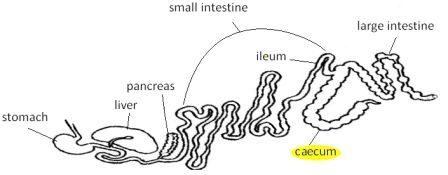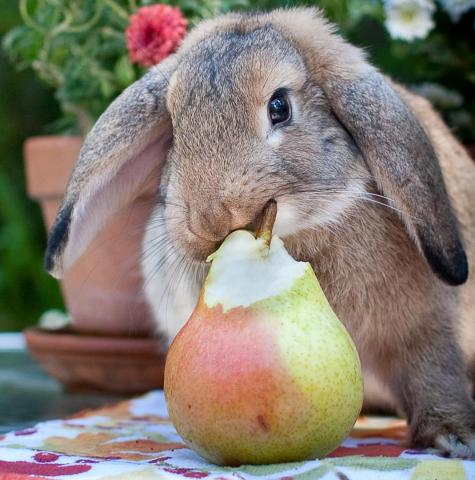Gastrointestinal stasis is the most common health problem affecting house rabbits. A life-threatening ailment, stasis requires immediate veterinary attention. A delay of even a few hours may mean death for the rabbit.
The rabbit digestive tract is in constant motion. In the wild, rabbits consume large amounts of grasses and leaves, which contain high concentrations of insoluble fiber. This insoluble fiber speeds up the intestinal tract, moving food quickly through the stomach and intestine. Where the small intestine meets the large intestine is a sac called the cecum, where soluble fiber is fermented. If there is little insoluble fiber in the rabbit’s diet, as is the case with house rabbits fed a diet of pellets, food backs up in the cecum, impeding the movement of the intestinal tract.

Here a vicious cycle begins: The rabbit’s system continues to pull water from the stomach contents, further slowing the movement of the food through the gut. The rabbit’s stomach feels full, so his appetite decreases. As he stops eating, movement in the gut slows further. Gradually the digestive system slows to a halt. The food in the stomach loses its liquid content, becoming an impacted mass of fur and fiber. This is often referred to as a “hairball,” but the root problem is not the ingestion of fur but rather insufficient fiber in the diet, leading to slower digestion.
Your first sign of trouble is likely to come when the rabbit refuses food. You may also notice that her droppings become small and hard or cease altogether. She may seem disinterested in her usual activities and may sit hunched in a ball, grinding her teeth in pain.
If the problem has not advanced very far, a large bowl of greens may serve to get the digestion moving again, but more often the rabbit is beyond eating at the point we notice the problem. Treatment involves quickly getting water and fiber into the digestive tract. Injections of fluids under the skin are the fastest way to get large amounts of fluid into the system. Your vet can provide lactated ringer solution and show you how to do subcutaneous injections, which you will need to do twice a day until the problem resolves. You will also need to force-feed the rabbit until he can be persuaded to start eating again on his own. Critical Care (from Oxbow Hay Company) is a convenient and effective emergency food that provides both liquid and fiber to help stimulate digestion.
If fluids and force-feeding are not sufficient, medication may be necessary. Reglan (metachlopromide) is effective in stimulating the upper digestive tract; Cisapride (propulsid) is used to stimulate the lower tract. These drugs can be dangerous if a blockage is present, but such cases are rare. Metacam, a painkiller, may help to reduce the rabbit’s discomfort.
Some rabbits are subject to repeated bouts of stasis. With these rabbits, it is particularly important to increase their hay consumption. Offer the rabbit unlimited high-quality timothy or orchard grass hay. Sprinkling the hay with herbs, such as rose hips, lavender, or chamomile, or severely restricting pellets may encourage the recalcitrant hay eater to eat more. Be sure to provide plenty of fresh water. Exercise is also important in keeping the digestive system working smoothly. Allow your rabbit at least 30 hours a week of free roaming. In difficult cases, it may be necessary to permanently eliminate pellets. If you do forgo pellets, be sure to provide an assortment of green vegetables to ensure proper nutrition.
Stasis need not be deadly. With thoughtful preventive care and a quick response to warning signs, even those rabbits with sluggish systems can lead long and healthy lives.

